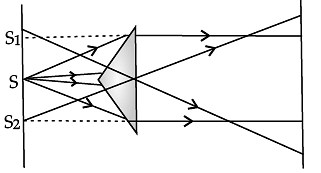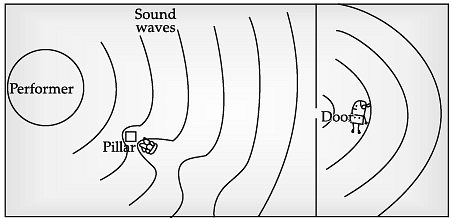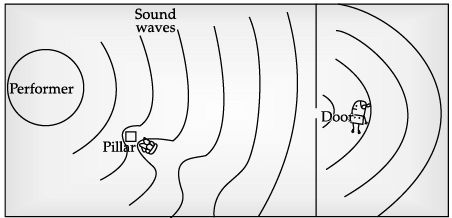Case Based Questions Test: Wave Optics - NEET MCQ
10 Questions MCQ Test Topic-wise MCQ Tests for NEET - Case Based Questions Test: Wave Optics
Read the following text and answer the following questions on the basis of the same:
In one of his experiments on interference, August Jean Fresnel used a biprism to induce interference between two beams. He split a diverging beam of light into two parts by using the biprism to refract them. This resulted in two split beams which acted as if they were from two coherent sources and which therefore interfered with each other.
A Fresnel Biprism is a thin double prism placed base to base and have very small refracting angle ( 0.5°). This is equivalent to a single prism with one of its angle nearly 179° and other two of 0.5° each.


In Young’s double Slits experiment, a single source is split in two coherent sources. For the Young’s slits experiment, we must approximate that the slits act as point sources. This however is not the case, since the slits have finite width. In this way, it gives rise to unwanted diffraction effects that causes errors.
The Fresnel biprism experiment overcomes this problem.
A Fresnel biprism is a variation of Young’s Slits experiment. When monochromatic light through a narrow slit falls on biprism that divides it into two components. One of these component is refracted from upper portion of biprism and the other one refracted through lower portion. Two virtual coherent sources formed from the original source. In this case, two virtual coherent sources are point sources and replace slits in Young’s experiment.
Q. Base angles of Fresnel biprism are:


Read the following text and answer the following questions on the basis of the same:
In one of his experiments on interference, August Jean Fresnel used a biprism to induce interference between two beams. He split a diverging beam of light into two parts by using the biprism to refract them. This resulted in two split beams which acted as if they were from two coherent sources and which therefore interfered with each other.
A Fresnel Biprism is a thin double prism placed base to base and have very small refracting angle ( 0.5°). This is equivalent to a single prism with one of its angle nearly 179° and other two of 0.5° each.


In Young’s double Slits experiment, a single source is split in two coherent sources. For the Young’s slits experiment, we must approximate that the slits act as point sources. This however is not the case, since the slits have finite width. In this way, it gives rise to unwanted diffraction effects that causes errors.
The Fresnel biprism experiment overcomes this problem.
A Fresnel biprism is a variation of Young’s Slits experiment. When monochromatic light through a narrow slit falls on biprism that divides it into two components. One of these component is refracted from upper portion of biprism and the other one refracted through lower portion. Two virtual coherent sources formed from the original source. In this case, two virtual coherent sources are point sources and replace slits in Young’s experiment.
Q. What is the difference between the coherent sources produced by Young’s double slit arrangement and Fresnel biprism?


| 1 Crore+ students have signed up on EduRev. Have you? Download the App |
Read the following text and answer the following questions on the basis of the same:
In one of his experiments on interference, August Jean Fresnel used a biprism to induce interference between two beams. He split a diverging beam of light into two parts by using the biprism to refract them. This resulted in two split beams which acted as if they were from two coherent sources and which therefore interfered with each other.
A Fresnel Biprism is a thin double prism placed base to base and have very small refracting angle ( 0.5°). This is equivalent to a single prism with one of its angle nearly 179° and other two of 0.5° each.


In Young’s double Slits experiment, a single source is split in two coherent sources. For the Young’s slits experiment, we must approximate that the slits act as point sources. This however is not the case, since the slits have finite width. In this way, it gives rise to unwanted diffraction effects that causes errors.
The Fresnel biprism experiment overcomes this problem.
A Fresnel biprism is a variation of Young’s Slits experiment. When monochromatic light through a narrow slit falls on biprism that divides it into two components. One of these component is refracted from upper portion of biprism and the other one refracted through lower portion. Two virtual coherent sources formed from the original source. In this case, two virtual coherent sources are point sources and replace slits in Young’s experiment.
Q. The Fresnel biprism is:


Read the following text and answer the following questions on the basis of the same:
In one of his experiments on interference, August Jean Fresnel used a biprism to induce interference between two beams. He split a diverging beam of light into two parts by using the biprism to refract them. This resulted in two split beams which acted as if they were from two coherent sources and which therefore interfered with each other.
A Fresnel Biprism is a thin double prism placed base to base and have very small refracting angle ( 0.5°). This is equivalent to a single prism with one of its angle nearly 179° and other two of 0.5° each.


In Young’s double Slits experiment, a single source is split in two coherent sources. For the Young’s slits experiment, we must approximate that the slits act as point sources. This however is not the case, since the slits have finite width. In this way, it gives rise to unwanted diffraction effects that causes errors.
The Fresnel biprism experiment overcomes this problem.
A Fresnel biprism is a variation of Young’s Slits experiment. When monochromatic light through a narrow slit falls on biprism that divides it into two components. One of these component is refracted from upper portion of biprism and the other one refracted through lower portion. Two virtual coherent sources formed from the original source. In this case, two virtual coherent sources are point sources and replace slits in Young’s experiment.
Q. Fresnel biprism produces:
Read the following text and answer the following questions on the basis of the same:
In one of his experiments on interference, August Jean Fresnel used a biprism to induce interference between two beams. He split a diverging beam of light into two parts by using the biprism to refract them. This resulted in two split beams which acted as if they were from two coherent sources and which therefore interfered with each other.
A Fresnel Biprism is a thin double prism placed base to base and have very small refracting angle ( 0.5°). This is equivalent to a single prism with one of its angle nearly 179° and other two of 0.5° each.


In Young’s double Slits experiment, a single source is split in two coherent sources. For the Young’s slits experiment, we must approximate that the slits act as point sources. This however is not the case, since the slits have finite width. In this way, it gives rise to unwanted diffraction effects that causes errors.
The Fresnel biprism experiment overcomes this problem.
A Fresnel biprism is a variation of Young’s Slits experiment. When monochromatic light through a narrow slit falls on biprism that divides it into two components. One of these component is refracted from upper portion of biprism and the other one refracted through lower portion. Two virtual coherent sources formed from the original source. In this case, two virtual coherent sources are point sources and replace slits in Young’s experiment.
Q. Which problem of Young’s double slit experiment is overcome by Fresnel biprism?
Read the following text and answer the following questions on the basis of the same:
Diffraction in a hall:
A and B went to purchase a ticket of a music programme. But unfortunately only one ticket was left. They purchased the single ticket and decided that A would be in the hall during the 1st half and B during the 2nd half.
Both of them reached the hall together. A entered the hall and found that the seat was behind a pillar which creates an obstacle. He was disappointed. He thought that he would not be able to hear the programme properly.
B was waiting outside the closed door. The door was not fully closed. There was a little opening.
But surprisingly, A could hear the music programme.
This happened due to diffraction of sound.
The fact we hear sounds around corners and around barriers involves both diffraction and reflection of sound.
Diffraction in such cases helps the sound to "bend around" the obstacles.
In fact, diffraction is more pronounced with longer wavelengths implies that we can hear low frequencies around obstacles better than high frequencies.
B was outside the door. He could also hear the programme. But he noticed that when the door opening is comparatively less he could hear the programme even being little away from the door. This is because when the width of the opening is larger than the wavelength of the wave passing through the gap then it does not spread out much on the other side. But when the opening is smaller than the wavelength more diffraction occurs and the waves spread out greatly – with semicircular wavefront. The opening in this case functions as a localized source of sound.

Q. Diffraction is more pronounced with ______ wavelengths.
Read the following text and answer the following questions on the basis of the same:
Diffraction in a hall:
A and B went to purchase a ticket of a music programme. But unfortunately only one ticket was left. They purchased the single ticket and decided that A would be in the hall during the 1st half and B during the 2nd half.
Both of them reached the hall together. A entered the hall and found that the seat was behind a pillar which creates an obstacle. He was disappointed. He thought that he would not be able to hear the programme properly.
B was waiting outside the closed door. The door was not fully closed. There was a little opening.
But surprisingly, A could hear the music programme.
This happened due to diffraction of sound.
The fact we hear sounds around corners and around barriers involves both diffraction and reflection of sound.
Diffraction in such cases helps the sound to "bend around" the obstacles.
In fact, diffraction is more pronounced with longer wavelengths implies that we can hear low frequencies around obstacles better than high frequencies.
B was outside the door. He could also hear the programme. But he noticed that when the door opening is comparatively less he could hear the programme even being little away from the door. This is because when the width of the opening is larger than the wavelength of the wave passing through the gap then it does not spread out much on the other side. But when the opening is smaller than the wavelength more diffraction occurs and the waves spread out greatly – with semicircular wavefront. The opening in this case functions as a localized source of sound.

Q. Diffraction of sound takes place more when :
Read the following text and answer the following questions on the basis of the same:
Diffraction in a hall:
A and B went to purchase a ticket of a music programme. But unfortunately only one ticket was left. They purchased the single ticket and decided that A would be in the hall during the 1st half and B during the 2nd half.
Both of them reached the hall together. A entered the hall and found that the seat was behind a pillar which creates an obstacle. He was disappointed. He thought that he would not be able to hear the programme properly.
B was waiting outside the closed door. The door was not fully closed. There was a little opening.
But surprisingly, A could hear the music programme.
This happened due to diffraction of sound.
The fact we hear sounds around corners and around barriers involves both diffraction and reflection of sound.
Diffraction in such cases helps the sound to "bend around" the obstacles.
In fact, diffraction is more pronounced with longer wavelengths implies that we can hear low frequencies around obstacles better than high frequencies.
B was outside the door. He could also hear the programme. But he noticed that when the door opening is comparatively less he could hear the programme even being little away from the door. This is because when the width of the opening is larger than the wavelength of the wave passing through the gap then it does not spread out much on the other side. But when the opening is smaller than the wavelength more diffraction occurs and the waves spread out greatly – with semicircular wavefront. The opening in this case functions as a localized source of sound.

Q. A and B could hear the music programme due to phenomenon named
Read the following text and answer the following questions on the basis of the same:
Diffraction in a hall:
A and B went to purchase a ticket of a music programme. But unfortunately only one ticket was left. They purchased the single ticket and decided that A would be in the hall during the 1st half and B during the 2nd half.
Both of them reached the hall together. A entered the hall and found that the seat was behind a pillar which creates an obstacle. He was disappointed. He thought that he would not be able to hear the programme properly.
B was waiting outside the closed door. The door was not fully closed. There was a little opening.
But surprisingly, A could hear the music programme.
This happened due to diffraction of sound.
The fact we hear sounds around corners and around barriers involves both diffraction and reflection of sound.
Diffraction in such cases helps the sound to "bend around" the obstacles.
In fact, diffraction is more pronounced with longer wavelengths implies that we can hear low frequencies around obstacles better than high frequencies.
B was outside the door. He could also hear the programme. But he noticed that when the door opening is comparatively less he could hear the programme even being little away from the door. This is because when the width of the opening is larger than the wavelength of the wave passing through the gap then it does not spread out much on the other side. But when the opening is smaller than the wavelength more diffraction occurs and the waves spread out greatly – with semicircular wavefront. The opening in this case functions as a localized source of sound.

Q. The minimum and maximum frequencies in the musical programme were 550 Hz and 10 kHz. Which frequency was better audible around the pillar obstacle?
Read the following text and answer the following questions on the basis of the same:
Diffraction in a hall:
A and B went to purchase a ticket of a music programme. But unfortunately only one ticket was left. They purchased the single ticket and decided that A would be in the hall during the 1st half and B during the 2nd half.
Both of them reached the hall together. A entered the hall and found that the seat was behind a pillar which creates an obstacle. He was disappointed. He thought that he would not be able to hear the programme properly.
B was waiting outside the closed door. The door was not fully closed. There was a little opening.
But surprisingly, A could hear the music programme.
This happened due to diffraction of sound.
The fact we hear sounds around corners and around barriers involves both diffraction and reflection of sound.
Diffraction in such cases helps the sound to "bend around" the obstacles.
In fact, diffraction is more pronounced with longer wavelengths implies that we can hear low frequencies around obstacles better than high frequencies.
B was outside the door. He could also hear the programme. But he noticed that when the door opening is comparatively less he could hear the programme even being little away from the door. This is because when the width of the opening is larger than the wavelength of the wave passing through the gap then it does not spread out much on the other side. But when the opening is smaller than the wavelength more diffraction occurs and the waves spread out greatly – with semicircular wavefront. The opening in this case functions as a localized source of sound.

Q. How the waveform will look like outside the door of the hall?
|
9 docs|1272 tests
|

















